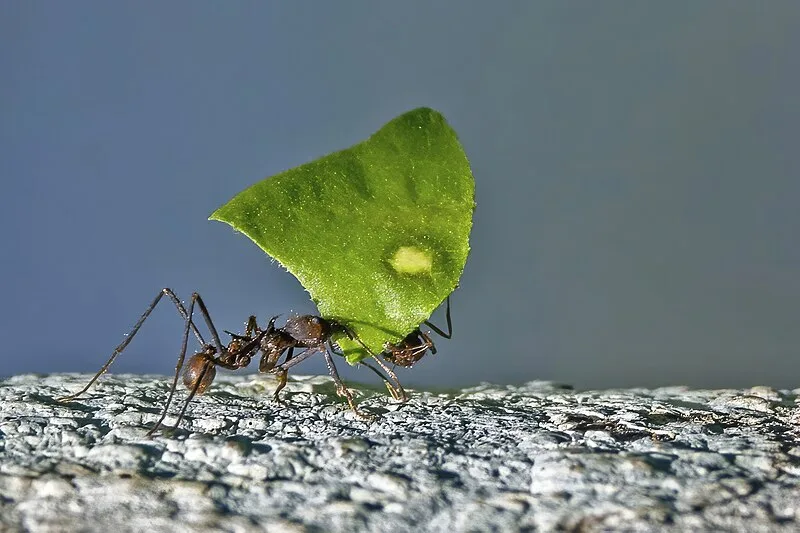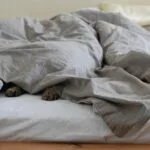The following story is popular on the Internet: supposedly the female of these ants, too huge to move on her own, and enclosed in a box of the strongest substance, in case of danger, can literally teleport herself and her fellow tribesmen to a safe place. And supposedly this ability has even been confirmed experimentally. We decided to check what science knows about this amazing ability of atta ants.
They write about teleporting ants bloggers, users literary services, entertainment sites, detailed articles are dedicated to atta sites with a selection of interesting facts. A significant part of publications both confirming the ability of ants to teleport and refuting her, refers to an article entitled “American Atta Ants That Can Teleport,” published in GeoFocus magazine in the November 2005 issue. The magazine itself is not available online, but users retell the text of the article, which states that the giant queen of these ants allegedly lives in a special concrete cocoon from which she cannot get out, and scientists allegedly recorded the inexplicable disappearance of a queen marked with paint from a cocoon and her appearance in another similar cocoon located at a distance.
Atta ants, too famous like leafcutter ants, a genus of ants that includes 39 species and lives primarily in the tropics of the New World. Attas cut 12–17% of all tropical forest foliage. On the one hand, this causes significant damage to pastures, on the other hand, it stimulates the growth of new shoots in plants. Atta ants are one of the few animals that engage in agricultural activities. They take some of the cut plants underground, where they feed Basidiomycota fungi, which, in turn, become the main food for ant larvae and additional food for adult ants. Adults are typically divided into castes: workers (including gardeners), soldiers, guards, and queens. Queen postpones an astonishing number of eggs: approximately 20 per minute, that is, 28,800 per day, or more than 10.5 million per year. Workers, soldiers and guards are sterile.
Once a year in a mature colony appear winged males and females capable of reproduction. Females place a piece of the fungus into the infrabuccal pouch, a special cavity under the esophagus, then the adults fly out of the mother colony. Each female is fertilized by up to ten males. This allows, firstly, to increase the genetic diversity within the future colony, and secondly, it provides the female with a sufficient amount of sperm for her entire life. After mating, the males die, and the females begin to create a new colony - they dig a nesting chamber in the soil and spit out the fungus from the infrabuccal pocket. The wings gradually atrophy, supplying the female with nutrients. The female feeds the first eggs to the mushroom, and eats some of them herself. The fungus also receives nutrition from her fecal fluid. After the fungus begins to grow, some of the eggs have a chance to develop. The female also feeds the resulting larvae with eggs. When the first offspring matures, it takes on the responsibilities of caring for the mushroom and the female. Sterile workers can lay trophic eggs - they also feed the queen, the fungus and the larvae. The colony becomes stable, and the female acts as an egg-laying machine for the rest of her life.
Although a mature female reaches At 20mm in length and workers only 4mm, this ratio is hardly the monstrous size mentioned in the viral story. Moreover, atta also does not have any super-strong camera (“so strong that it can only be destroyed with a heavy crowbar”). All tunnels and chambers dug in the ground, the most that is used to create a solid structure primarily for ventilation shafts is clay and sand. This description from the viral story also does not coincide with reality: “These chambers are the size of a coconut” and “This large insect takes up the entire chamber.” Length the average coconut is 35–40 cm, and the queen is only 2 cm. In 2013, scientists from the Maryland Center for Systematic Entomology studied structure of four atta colonies. The chambers in which the queens were located turned out to be quite modest in size - no more than 10 cm, and besides the female, they also contained a mushroom, workers and growing winged males and females. Scientists have not discovered any materials similar in strength to cement. At the same time, when describing their actions, they, on the contrary, emphasized how painstaking work it was, since any careless movement would lead to the destruction of the chambers and tunnels.
Not in any scientific databases of publications (PubMed, Google Scholar), as well as in major scientific journals (Nature, Science) there is no mention of teleportation in atta ants. However, using keywords you can find out, that the teleportation of atta was reported in 1938 by the British naturalist Ivan Sanderson. After receiving a bachelor's degree in zoology and then a master's degree in botany and geology, Sanderson became interested in cryptozoology, a pseudoscience that studies animals unknown to science. The cryptozoologists themselves think his father of this movement and they claim that Sanderson is the author of the name. In his book "Creatures" just is told the whole story with teleportation, which formed the basis of the viral post. It includes details such as a “chamber the size of a coconut,” “a durable chamber that can only be destroyed with a crowbar,” “a giant queen occupying the entire chamber,” as well as all the details of the queen being painted, the chamber being closed, and the same marked queen being found at a distance from the destroyed chamber. In addition to teleportation, Sanderson writes about telepathy in the same chapter:
“There are several hypotheses. One of them comes down to electromagnetic signals - but keep in mind, the Russians seem to have proven that human telepathic signals do not fall on the electromagnetic spectrum. They placed subjects susceptible to hypnosis in special devices that were shielded from electromagnetic waves, and found that the telepathic connection was not interrupted."
In addition to atta ants, Sanderson describes encounters with marikoxi (ape people), tunijuk (Eskimo Bigfoot), flying saucers, self-flying rocks, and the Loch Ness monster. Moreover, Sanderson sincerely believed in everything he described. In the epilogue he notes:
“The “things” that I told you about exist, but they do not fit into any of the known categories of “things” at all! They are all real, physical, concrete and actually existing things that can be weighed or measured or both in some scientific way or another.”
It is impossible to reliably know what exactly Sanderson saw in the case of the atta ants, since he does not indicate the names of those who were with him on the expedition, the year of the expedition, the exact location of the observation, and even the specific type of atta (of which 39 are known). However, we can say for sure that what is described in many ways does not coincide with how the atta colony functions in reality.
Thus, the widely circulated story that atta ants can teleport is nothing more than a retelling of the story of a cryptozoologist from the middle of the last century. In his story, Sanderson makes many factual errors in describing the life of the ant colony, and also does not indicate either the species that he and his assistants observed, or the place where he made his observations. It is impossible to find out what he actually did and saw, but no one except him noted any teleportation atta.
Cover image: Charles J. Sharp, CC BY-SA 4.0, via Wikimedia Commons
If you find a spelling or grammatical error, please let us know by highlighting the error text and clicking Ctrl+Enter.






